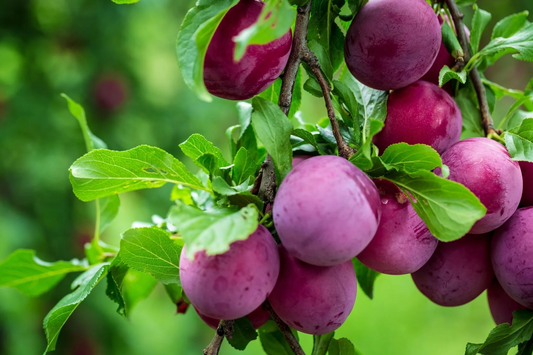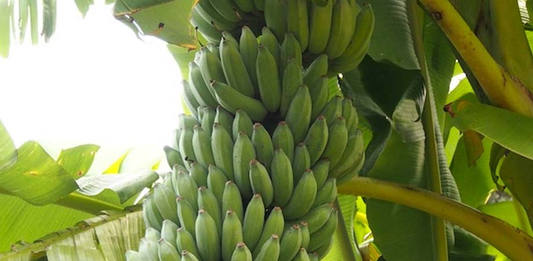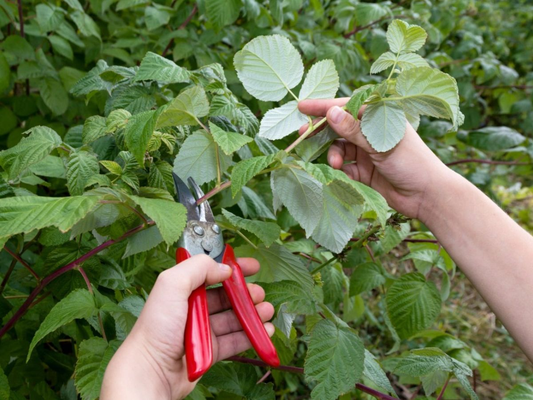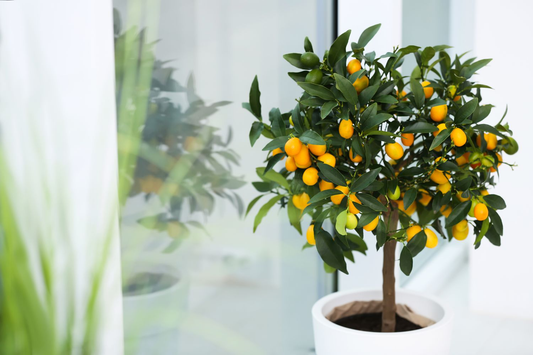Best Methods for Harvesting Fruit Trees
Share
- 1. Introduction
- 2. Understanding Fruit Maturity
- 3. Timing: The Key to Quality Harvests
- 4. Hand-Harvesting Techniques
- 5. Using Harvesting Tools and Equipment
- 6. Harvesting in Different Climates
- 7. Best Practices for Harvesting Specific Fruits
- 8. Harvesting Fruit with Minimal Impact
- 9. Post-Harvest Care
- 10. Common Harvesting Mistakes to Avoid
- 11. FAQ – Frequently Asked Questions
1. Introduction
Harvesting fruit trees at the right time is crucial for ensuring the best possible flavor, texture, and nutritional value of your fruits. Whether you're an experienced gardener or a beginner, understanding the right time and method to harvest fruit can significantly affect the quality of your harvest. Picking too early can result in underdeveloped, sour fruits, while waiting too long can lead to overripe or damaged produce.
There are several methods for harvesting fruit, each having its own impact on the fruit's quality. The primary goal of any harvesting method is to minimize damage while ensuring the fruit is collected at its peak ripeness. Below are some of the methods commonly used for fruit tree harvesting:
- Hand-picking: The traditional and most gentle method for harvesting, where fruit is picked by hand to avoid bruising.
- Using tools: Ladders, fruit-picking poles, and other tools can be used to harvest fruit from taller trees or hard-to-reach branches.
- Mechanical harvesting: For large-scale orchards, mechanical harvesting equipment is used to shake trees and collect fruit quickly.
- Timing-based methods: Harvesting based on the fruit’s ripening cues like color, firmness, and ease of detachment.
In this blog, we will cover:
- How to determine the right time to harvest – Learn the signs of ripeness for different fruit types.
- Different harvesting methods – Explore hand-picking, using tools, and mechanical harvesting techniques.
- Best practices for optimal fruit quality – Discover tips for minimizing damage and ensuring the highest quality harvest.
- Post-harvest care – Understand how to store and handle fruits after they are picked to maximize freshness.
By following the right techniques and methods for harvesting, you'll be able to enjoy fresh, flavorful fruits and ensure your trees remain healthy for future harvests.

2. Understanding Fruit Maturity
Fruit maturity refers to the stage at which a fruit has fully developed its flavor, texture, and nutritional value. Harvesting fruit at the right stage of maturity ensures that you get the best quality produce, with optimal taste, sweetness, and shelf life. Picking fruit too early can result in underdeveloped, sour produce, while waiting too long can lead to overripe, mushy fruit.
There are several ways to determine if a fruit is ready for harvest, and these can vary depending on the type of fruit. Key indicators of maturity include:
- Color: Changes in color are often the first sign that a fruit is nearing maturity. For example, apples transition from green to red or yellow, and peaches shift from green to a golden hue.
- Texture: The fruit should feel firm but not hard. For many fruits, like peaches or pears, they may still ripen after being picked, but they need to be at a specific texture when harvested.
- Size: Many fruits reach their full size when they are mature. Compare to a typical size for the variety to gauge readiness.
In addition to visual cues, taste and smell are key indicators of maturity:
- Taste: A mature fruit should taste sweet, juicy, and full of flavor. Test the fruit by gently biting into it to assess its sweetness and texture.
- Smell: A ripe fruit often gives off a distinct fragrance, signaling that it has reached its peak.
The concept of a "seasonal window" is essential in harvesting, as the best time to pick fruit depends on its variety and local climate. Different fruits have specific harvesting windows:
- Apples: Typically harvested in late summer to fall, depending on variety.
- Pears: Often harvested when still firm, typically in late summer to early fall.
- Peaches: Best harvested in mid-summer when fully colored and slightly soft.
- Cherries: Typically harvested in late spring to early summer when they reach their full color.
- Citrus fruits: Can be harvested in late fall to winter, depending on type and climate.
Knowing the right "seasonal window" for each fruit type helps ensure you harvest them at their optimal maturity, ensuring the best taste and quality.
3. Timing: The Key to Quality Harvests
Timing is one of the most important factors when it comes to harvesting fruit trees. Harvesting at the right moment ensures that the fruits have reached their peak flavor, texture, and quality. Picking fruits too early or too late can result in poor taste, shorter shelf life, and potentially wasted produce.
The ideal harvest time varies depending on the type of fruit, and it is typically categorized as early, mid, or late-season. Below is a breakdown of typical harvest times for popular fruit trees:
- Apples: Usually harvested in late summer to early fall, depending on the variety. Some early-season varieties like 'Gravenstein' ripen in late summer, while mid-season varieties like 'Fuji' are ready in early fall.
- Pears: Often harvested in late summer to early fall. Pears should be picked when firm but not fully ripe, as they will continue to ripen off the tree. Varieties like 'Bartlett' are typically ready in late summer.
- Peaches: Harvested in mid-summer. Peaches reach their peak when they are fully colored and slightly soft to the touch, with varieties like 'Freestone' being ready from July to August.
- Figs: Figs are generally harvested in late summer to early fall. Varieties such as 'Brown Turkey' ripen in late summer, and should be picked when soft to the touch.
- Cherries: Harvested in late spring to early summer. Cherries should be picked when fully ripe, typically in June, with varieties like 'Bing' ready for harvest in early summer.
- Citrus fruits: Depending on the variety, citrus fruits are typically harvested in late fall to winter, with oranges, grapefruits, and lemons ripening in this period, from November through January.
Weather conditions play a significant role in determining the harvest time. Warm temperatures and extended sunny days can accelerate fruit ripening, while cool or wet weather can delay it. For instance:
- In tropical climates: Fruits like mangoes and citrus may ripen year-round, with a focus on specific rainy seasons.
- In temperate climates: The harvest season is more distinct, with fruits like apples and peaches ripening during the warmer months, followed by figs and citrus in the fall and winter.
4. Hand-Harvesting Techniques
Hand-picking is the most common and traditional method of harvesting fruit trees, and it's widely used for its gentle approach to picking fruits. This technique allows gardeners to carefully select the best fruits while minimizing the risk of damaging the tree or the produce. Unlike mechanical harvesting, which can cause bruising, hand-picking ensures that the fruits remain intact, retaining their quality and extending their shelf life.
To successfully hand-harvest fruit, the right tools are essential. Some common tools for hand-harvesting include:
- Pruning Shears: Ideal for cutting fruit stems cleanly without damaging the tree. These are especially helpful for small fruits like apples, pears, and peaches that require precision.
- Picking Poles: These extendable poles help harvest fruits from higher branches without needing a ladder. They usually have a soft, padded claw at the end to gently grab and pull the fruit off the tree.
- Harvest Baskets: Baskets or cloth bags should be used to collect fruits, preventing bruising and allowing for easy transport to storage areas.
When hand-picking, it's important to follow best practices to avoid damaging the tree and the fruit:
- Use the right technique: When picking fruit, twist it gently or use the shears to cut the stem. Avoid pulling fruit too hard, as this can damage the tree's branches or cause fruit to bruise.
- Check for ripeness: Make sure the fruit is at the correct stage of maturity, ensuring it's ready for picking without overripe or underripe issues.
- Wear protective gear: Gloves can help protect your hands from thorny branches or sap, and sturdy shoes will keep you safe when climbing ladders.
Techniques will vary depending on the type of tree being harvested:
- Dwarf Trees: These are usually easy to reach, so picking can be done from the ground. However, be mindful of the small branches, which may be more fragile than those on larger trees.
- Standard-sized Trees: A ladder may be needed to reach higher branches. Always position the ladder securely before climbing, and ensure you have proper balance while harvesting.
- Espaliered Trees: With their flat, trained structure, espaliered trees make hand-picking easier, but careful attention should be paid to ensure the branches don't break under pressure.
When it comes to hand-harvesting, the key concept is "gentle picking." This means carefully removing fruits with a soft touch to avoid bruising or causing any damage. Even small amounts of force can impact the fruit’s skin, leading to unsightly marks or reducing its shelf life. Always handle fruit with care, ensuring that the picking process doesn't cause any harm to the fruit or tree.

5. Using Harvesting Tools and Equipment
While hand-picking is the most common method for harvesting fruits, specialized tools and equipment can make the process more efficient and safer, especially for large or high trees. These tools allow gardeners and orchardists to harvest large quantities of fruit while minimizing damage to both the tree and the fruit. Below is an overview of the various tools and equipment used in fruit harvesting:
- Fruit Picking Poles: These extendable poles help reach fruits on high branches. They typically have a soft, padded claw or basket at the end that gently grabs and pulls the fruit from the tree. Picking poles are especially useful for fruits like apples, pears, and cherries. They reduce the need for ladders and make harvesting faster.
- Ladders and Scaffolding: For trees with high branches, ladders are indispensable. A sturdy ladder provides the support needed to reach fruits in the upper canopy. Scaffolding systems, which are more permanent and often used in commercial orchards, provide even more stability and safety when harvesting from very tall trees, such as those in orchards with large fruiting trees.
- Harvest Bags and Baskets: Soft, lightweight harvest bags or baskets should be used to collect fruits. These bags prevent bruising and ensure that the fruit is transported without damage. Hanging harvest baskets can be particularly useful for harvesting from high trees, as they can be clipped onto the ladder or scaffold to collect fruit as it is picked.
-
Specialized Tools: Certain fruits require specialized tools for harvesting:
- Citrus Harvesting Tools: For citrus trees, a pole with a fruit-catching bag or claw is often used, as citrus fruits grow in clusters and can be difficult to harvest by hand.
- Olive Harvesting Rakes: Olives are typically harvested with rakes or combs that gently shake the branches to release the fruit. Specialized olive harvesting machines may also be used for large orchards.
When considering whether to use tools or hand-picking, there are some pros and cons to keep in mind:
| Method | Pros | Cons |
|---|---|---|
| Tools (e.g., poles, ladders, baskets) |
|
|
| Hand-Picking |
|
|
Safety is crucial when using ladders or other equipment for harvesting. Always ensure that the ladder is placed on level ground and securely positioned before climbing. When using tall scaffolding or other equipment, be sure to follow all safety guidelines and use any necessary protective gear, such as helmets and gloves, to prevent accidents.
6. Harvesting in Different Climates
The climate in which a fruit tree is grown significantly influences the harvesting process. Different climates—tropical, temperate, and arid—pose unique challenges and considerations for fruit harvesters. Understanding these factors helps optimize the timing and methods for harvesting to ensure fruit quality. Below, we explore how harvesting methods adapt to various climate zones and the special considerations needed in each environment.
1. Tropical Climates
Tropical climates are characterized by warm temperatures and high humidity, making them ideal for growing a variety of exotic fruits. However, there are some key considerations for harvesting in these conditions:
- Timing: Fruits in tropical climates, such as mangoes, papayas, and pineapples, often ripen year-round or in two distinct seasons. Harvesting should occur when the fruit reaches full color and size, but before it over-ripens, as high humidity can lead to rapid decay.
- Moisture Management: High humidity can cause mold or mildew on fruit. Harvesting during dry periods or using dehumidifying methods can help reduce this risk.
- Tools: Tools like picking poles are particularly useful for reaching high fruits like mangoes. A delicate touch is required to avoid bruising or damaging the fruit, especially when humidity levels are high.
2. Temperate Climates
Temperate climates experience distinct seasons, with warm summers and cold winters. Fruit trees such as apples, pears, and peaches thrive in these conditions. Special considerations include:
- Temperature: Fruit ripening is more predictable in temperate climates, but it is important to watch for early frost. Frost can damage fruit still on the tree, so harvesting should occur before the first frost to prevent fruit from being ruined.
- Seasonal Window: In temperate regions, fruits like apples and peaches often have a short harvest window. The timing of harvest can vary slightly depending on the variety, so it’s important to monitor the fruits closely.
- Weather Variability: Cold nights followed by warm days can accelerate ripening. Pay close attention to this temperature fluctuation, as it can speed up harvest timing.
3. Arid Climates
Arid or desert climates have hot temperatures and low humidity, which presents its own set of challenges for fruit harvesting. Fruit trees such as figs, olives, and certain varieties of citrus are well-suited for dry climates. Special considerations include:
- Watering Needs: In arid regions, water management is crucial. Trees need adequate irrigation, especially during fruiting seasons, as lack of water can result in stunted fruit growth.
- Sun Exposure: Excessive sunlight can cause fruit to overheat and ripen unevenly. It's essential to harvest in the early morning or late evening when the sun is less intense.
- Wind Protection: Strong winds can damage delicate fruit. Harvesting during calmer weather is ideal to avoid fruit being blown off the tree prematurely.
Examples of Fruit Trees in Different Climates
Here are some examples of fruit trees that thrive in these respective climates:
| Climate Zone | Examples of Fruit Trees |
|---|---|
| Tropical | Mango, Papaya, Banana, Pineapple |
| Temperate | Apple, Pear, Peach, Plum |
| Arid | Fig, Olive, Citrus, Pomegranate |
Each climate zone has its unique set of challenges and opportunities when it comes to harvesting. Understanding these environmental factors and tailoring your harvesting techniques accordingly ensures the best fruit quality and minimizes the risk of damage during harvest.

7. Best Practices for Harvesting Specific Fruits
Each type of fruit tree has its own set of harvesting practices to ensure you get the best flavor and texture. Understanding the specific needs for each fruit, such as when to harvest, how to handle delicate varieties, and the right tools for the job, is crucial for a successful harvest. Here’s a detailed guide to help you harvest different fruits with confidence:
1. Apples
Apples are one of the most popular fruits to harvest, and getting the timing just right is essential for peak ripeness. Here’s how to ensure you harvest your apples at the right time:
- Peak Ripeness: Apples should be picked when they are firm, full of color, and the seeds inside turn brown. Avoid waiting until they fall from the tree, as they can become overripe.
-
Different Varieties:
- Granny Smith: Harvest when the green color is deep and the fruit has a firm texture.
- Fuji: These apples should be picked when they are sweet but still firm.
- Gala: Harvest when the apples have a fragrant smell and the color is rich red-orange.
- Harvest Technique: Twist and lift the apple gently to avoid bruising. Use pruning shears for hard-to-reach apples.
2. Pears
Pears are unique because they are often harvested slightly under-ripe to ensure they ripen properly off the tree.
- Peak Ripeness: Pears should be picked while they are still firm. Check the neck of the pear—when it’s soft to the touch, the pear is ripe.
- Ripening Off the Tree: Pears ripen best when stored at room temperature after picking. Refrigerate them if they ripen too quickly to slow the process.
- Harvesting Technique: Gently twist the pear off the stem, as pulling can cause bruising.
3. Peaches and Nectarines
Peaches and nectarines are sensitive fruits, so it’s important to pick them at the right moment to avoid them becoming overripe.
- Peak Ripeness: Peaches and nectarines should be soft but not mushy. Look for a deep, vibrant color and a slight give when you press gently.
-
Soft vs. Firm Varieties:
- Soft varieties: Harvest when the fruit is fully ripe and soft to the touch.
- Firm varieties: Harvest when they are slightly firm and allow them to ripen at room temperature.
- Harvesting Technique: Pick gently to avoid bruising. Use pruning shears for hard-to-reach branches.
4. Cherries
Cherries are delicate fruits that require special care during harvest to avoid crushing or bruising.
- Peak Ripeness: Cherries should be fully ripe, with a deep red color (or yellow, depending on the variety) and firm texture. Taste test a few to ensure sweetness.
- Harvesting Technique: Use both hands to gently twist the stem off the branch. Avoid pulling on the fruit directly, as this can damage the tree and other fruits.
5. Figs
Figs are a delicate fruit, and they must be harvested at the right moment to ensure they are sweet and flavorful without becoming overripe.
- Peak Ripeness: Figs should be soft but not mushy. The fruit should bend slightly at the neck and feel heavy for its size.
- Harvesting Technique: Gently pull the fig from the tree, ensuring it detaches easily. Handle with care to avoid bruising.
6. Citrus Fruits (Oranges, Lemons, etc.)
Citrus fruits, such as oranges, lemons, and limes, are relatively easy to harvest, but the key is ensuring they are fully ripe before picking.
- Peak Ripeness: Citrus fruits should have a vibrant color and be firm to the touch. The fruit should feel heavy for its size.
- Harvesting Technique: Cut the fruit from the tree with pruning shears or use a fruit picker for high branches. Twist gently to detach the fruit from the stem.
Harvesting Summary Table
| Fruit | Harvest Time | Ripeness Indicators | Harvesting Techniques |
|---|---|---|---|
| Apples | When firm and full-colored, before falling from the tree. | Color change, firm texture, seeds turn brown. | Twist and lift gently to avoid bruising, use pruning shears for hard-to-reach apples. |
| Pears | Harvest slightly under-ripe, and ripen off the tree. | Firm but with a soft neck when ripe. | Twist gently to detach, avoid pulling. |
| Peaches & Nectarines | When soft (for soft varieties) or firm (for firm varieties). | Soft to the touch, vibrant color. | Pick gently to avoid bruising. |
| Cherries | Fully ripe with a deep red or yellow color. | Firm texture and sweetness. | Use both hands to twist the stem off. |
| Figs | When soft but not mushy. | Soft to the touch, bends at the neck. | Gently pull from the tree, avoiding bruising. |
| Citrus Fruits | When firm and vibrant in color. | Heavy for size, firm texture. | Cut with pruning shears, twist gently to detach. |
By following these best practices for each specific fruit type, you can ensure a high-quality harvest that enhances your fruit tree’s yield and flavor. Whether you're picking apples, figs, or citrus fruits, proper timing and technique are essential for preserving the quality of your fruit.

8. Harvesting Fruit with Minimal Impact
Harvesting fruit from your trees should not only focus on maximizing yield but also on ensuring the long-term health of the tree. Sustainable harvesting practices help protect the tree, improve future harvests, and contribute positively to the environment. Here are some key principles to follow when harvesting fruit with minimal impact:
1. Environmental Considerations of Fruit Harvesting
- Tree Health: Harvesting should be done in a way that doesn't damage the tree’s branches, bark, or leaves. Proper techniques ensure that the tree remains healthy and capable of producing fruit in subsequent seasons.
- Soil and Ecosystem: Over-harvesting can affect soil quality and disrupt the local ecosystem. Sustainable practices help maintain soil integrity and biodiversity, benefiting not only the tree but also the surrounding environment.
2. Ensuring Minimal Impact on the Tree’s Health
- Avoid Over-Picking: Never pick all the fruit off the tree at once. Leaving some fruit behind allows the tree to replenish and ensures it has enough energy for the following growing season.
- Proper Pruning and Cutting: Use clean, sharp tools when removing fruit or cutting branches to prevent injury to the tree. Wound sites should be minimized, as they can attract pests and diseases.
- Leave Fruit for Pollination: Ensure some fruit remains on the tree to attract pollinators, supporting future fruiting seasons.
3. Sustainable Harvesting Practices and Benefits
- Long-Term Yields: By adopting sustainable practices, such as avoiding over-harvesting and ensuring clean cuts, you allow the tree to thrive and yield fruit in future seasons.
- Preserving Natural Resources: Sustainable harvesting practices help preserve water, soil, and other natural resources necessary for tree growth.
- Environmental Responsibility: Sustainable harvesting reduces the environmental footprint, ensuring the health of both the tree and the surrounding ecosystem.
9. Post-Harvest Care
Once the fruit is harvested, proper handling and storage are crucial to preserving its quality, flavor, and shelf life. The way you manage your harvest can prevent spoilage, reduce waste, and ensure that you enjoy your fruit at its best. Here are some tips for proper post-harvest care:
1. Preventing Bruising, Spoilage, and Pests
- Handle Gently: Fruits should be handled with care to prevent bruising. Avoid dropping or stacking heavy loads of fruit on top of each other.
- Inspect Regularly: Check harvested fruit for any signs of damage or pests. Remove any bruised or damaged fruits to prevent them from affecting others.
- Clean Storage: Ensure that storage containers or areas are clean and dry. Dampness can encourage mold growth and spoilage.
2. Ripening Underripe Fruits
- Apples and Pears: These fruits are often harvested slightly underripe and need to ripen off the tree. Place them in a cool, dark place for 1-2 weeks to allow them to ripen properly.
- Ethylene Gas: Fruits like apples, pears, and avocados can be placed near each other as they release ethylene gas, which speeds up the ripening process.
3. Ideal Storage Conditions
- Temperature: Most fruits should be stored in a cool environment. Apples, pears, and stone fruits do well at temperatures between 30-40°F (1-4°C). Citrus fruits, however, should be stored at room temperature.
- Humidity: Some fruits, like berries and grapes, require higher humidity to maintain freshness. Store them in a slightly humid environment, such as a fridge crisper drawer.
4. Preservation Methods
- Canning: This is a popular method for long-term storage, especially for fruits like peaches and apples. Canning helps preserve fruit by sealing it in airtight containers.
- Freezing: Fruits like berries and figs can be frozen for long-term storage. Ensure fruits are prepped and frozen in single layers before packing into bags to avoid clumping.
- Drying: Dehydrating fruits like apples, pears, and cherries is another excellent preservation method. Use a dehydrator or an oven on a low setting to remove moisture, which helps prevent spoilage.
Proper post-harvest care ensures that your fruit remains fresh, flavorful, and free from spoilage. By using these handling, storage, and preservation methods, you can extend the life of your fruit and enjoy it long after the harvest season ends.

10. Common Harvesting Mistakes to Avoid
While harvesting fruit trees, it’s easy to make mistakes that can impact the quality of the fruit, the health of the tree, and future yields. Here are some common harvesting mistakes gardeners and orchardists should avoid:
1. Over-Picking or Picking Too Early/Late
- Over-Picking: Harvesting too much fruit at once can stress the tree and reduce future yields. Ensure you leave some fruit behind to allow the tree to replenish and maintain its health.
- Picking Too Early: Harvesting fruit before it’s fully ripe can lead to poor flavor and texture. Be patient and wait for the right moment to pick, as premature harvesting can lead to disappointing results.
- Picking Too Late: Allowing fruit to over-ripen on the tree can result in mushy or spoiled fruit. Check regularly and harvest when fruits are at their peak ripeness.
2. Using Improper Tools or Handling Techniques
- Damaging Fruit or Trees: Using dull or inappropriate tools, such as blunt pruning shears or unclean hands, can damage both the fruit and the tree. Always use clean, sharp tools, and handle fruit gently to avoid bruising or breaking branches.
- Improper Picking Technique: Pulling fruit too forcefully can result in unnecessary stress on the tree and cause injuries. Instead, use a twisting or gentle cutting motion to avoid damaging branches and bark.
3. Harvesting Too Frequently
- Causing Undue Stress: Harvesting fruit too often can deplete the tree’s resources, preventing it from properly replenishing and growing future fruit. Limit harvesting to prevent overtaxing the tree.
4. Not Considering the Tree’s Growth Stage
- Premature Harvesting: Failing to take the tree’s growth stage into account can result in fruit that is not fully ripened. Always observe signs of maturity, such as color, size, and texture, and allow the tree to complete its natural growth cycle.
Avoiding these common mistakes will ensure a successful harvest, promote the health of your trees, and provide you with high-quality fruit for future seasons.
11. FAQ – Frequently Asked Questions
Here are some frequently asked questions regarding the harvesting of fruit trees:
1. What are the best tools for harvesting fruit trees?
- The best tools for harvesting include sharp pruning shears, fruit picking poles for high branches, and harvest baskets to carry the fruit. For delicate fruits like cherries, specialized picking gloves can help prevent bruising.
2. How do I know if my fruit is ripe enough to pick?
- Fruit ripeness can be determined by its color, size, and texture. For example, apples should have a deep color and give slightly when pressed. The fruit should also emit a sweet fragrance and feel heavy for its size.
3. Can I harvest fruit early and ripen it indoors?
- Yes, some fruits like pears and apples can be harvested slightly underripe and ripened indoors. Store them in a cool, dark place and allow them to ripen naturally, checking regularly.
4. What is the difference between hand-picking and using equipment?
- Hand-picking is more gentle and suitable for delicate fruits. It allows better control, preventing damage to both fruit and tree. Equipment like ladders and picking poles can be used for high branches but may risk damaging fruit if not handled carefully.
5. Why should I avoid over-picking my fruit trees?
- Over-picking can stress the tree, depleting its energy reserves and impacting its ability to produce fruit in future seasons. It’s important to leave enough fruit for the tree to maintain its health and regeneration.
6. How do I store harvested fruit to keep it fresh longer?
- Store harvested fruit in cool, dark places with proper humidity. Use breathable containers like crates or baskets, and avoid stacking fruits too high. For some fruits, refrigeration or controlled storage environments are required to extend shelf life.
7. Can fruit trees suffer if too much is harvested in one season?
- Yes, over-harvesting can damage fruit trees by depleting their resources and hindering future growth. It can also leave the tree vulnerable to disease and stress, affecting future fruit production.
Additional Resources
Best Varieties of Strawberries for Your Garden




